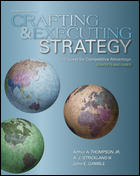Thompson, Strickland and Gambles’, CRAFTING AND EXECUTING STRATEGY, 16e presents the latest research findings from the literature and cutting-edge strategic practices of companies have been incorporated to keep step with both theory and practice. The chapter content continues to be solidly mainstream and balanced, mirroring both the best academic thinking and the pragmatism of real-world strategic management.
Known for its cases and teaching notes, CRAFTING AND EXECUTING STRATEGY, 16e provides an unparalleled case line up.
(1) 28 of the 31 cases are new to this edition, (2) The selection of cases is diverse, timely, and thoughtfully-crafted and
complements the text presentation pushing students to apply the concepts and analytical tools they have read about. (3) Many
cases involve high-profile companies. (4) And there’s a comprehensive package of support materials that are a breeze
to use, highly effective, and flexible enough to fit most any course design.
About the Author
A.J. (Lonnie)
Strickland received a BS in Math and Physics from the University of Georgia, an MS in Industrial Management from Georgia Institute
of Technology, and a PhD from Georgia State university. He currently holds the rank of Professor of Strategic Management in
the Graduate School of Business at the University of Alabama. He has done extensive consulting and research work. In recent
years, he was honored with the Outstanding Professor Award for the Graduate School of Business, and was the recipient of the
Outstanding Commitment to Teaching Award for the University of Alabama.
John E. Gamble is currently Associate Dean
and Professor of Management in the Mitchell College of Business at the University of South Alabama. His teaching specialty
at USA is strategic management and he also conducts a course in strategic management in Germany, which is sponsored by the
University of Applied Sciences in Worms.
Dr. Gamble's research interests center on strategic issues in entrepreneurial, health care, and manufacturing settings. His work has been published in various scholarly journals and he is the author or co-author of more than 50 case studies published in an assortment of strategic management and strategic marketing texts. He has done consulting on industry and market analysis for clients in a diverse mix of industries.
Professor Gamble received his Ph.D. in management from the University of Alabama in 1995. Dr. Gamble also has a Bachelor of Science degree and a Master of Arts degree from the University of Alabama.

